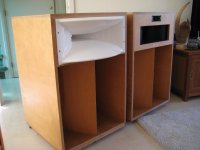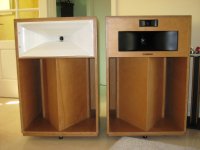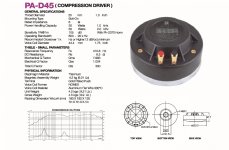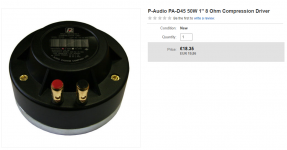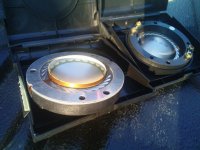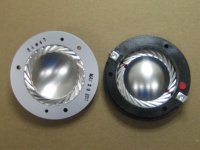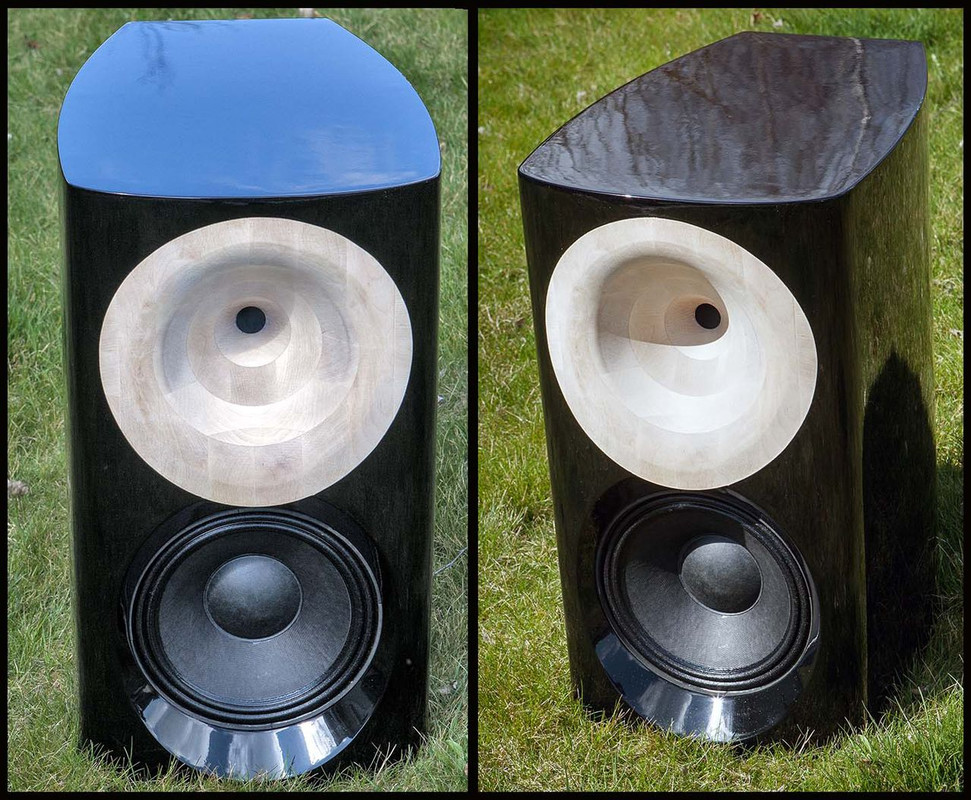So this is what one of Mabat's horns looks like in a LaScala like enclosure. Pretty cool stuf for only an hour spend (excl. waiting for the simulation to finish) 🙂.
Reminds me of this LaScala mod, by a fellow Dutchman btw.
Attachments
Hi Ro808
I apologize for the inappropriate word ... a 911 Carrera S would suit me, too bad my finances won't let me ... lol, but I think you understood the concept.
I will remember your post, although I believe that at least one trial with 15p80 will be worth it. I want to clarify that they will be driven by a final of only 20 W and therefore it becomes mandatory to choose the most efficient woofer logically. In any case, thanks for the valuable advice and greetings.
Mleod
You're welcome.
Here's a 1 page thread regarding the Beyma, with some comments by djk. Also note the woofer that, once more, is referred to in the last post.
Here's another thread including, no kidding, THAT driver...AGAIN.
BTW, one more thing I remember was that the driver used (P.Audio PA-D45) was very clean sounding during the (very loud) sweeps for the measurements. Much more than DE500 that we measured right before in a similar speaker. Does it really mean something? I don't know, it's just that everybody noticed. The target crossover point was around 700 Hz IIRC.
IOW the P.Audio PA-D45 sounded better than the DE500, especially around and below 1000Hz?
That doesn't surprise me in the least. Not so many pages ago, I posted a similar comment regarding the DE500.
The P.Audio offers tremendous value.
Attachments
Last edited:
I got these very cheaply in a sale years ago and I still have a pair. It's not quite typical 1" driver. It was definitely cleaner during the sweeps - probably well below 1 kHz, I didn't measure the distortion. So it could be crossed over quite low for a 1" (1.75" diaphragm) I guess. In fact, this was the stimulus to build the big speakers - "let's build something big with this". Usually it's the other way around 🙂
Last edited:
Indeed, it seems the PA-D45 shares some properties with the vintage drivers, like the 1" Altecs.
1, 2: PA-D45 diaphragm
3: Altec replacement diaphragm (GPA)
1, 2: PA-D45 diaphragm
3: Altec replacement diaphragm (GPA)
Attachments
Last edited:
This led me to buy PA-D99 when I saw them in a sale - I didn't hesitate a minute. Still wondering what to build with those 😀
P.Audio PA-D99 Monster 2″ 150W Compression Driver << blog.bluearan.co.uk
P.Audio PA-D99 Monster 2″ 150W Compression Driver << blog.bluearan.co.uk
Is this a concept for the 15" + 1" you showed ?
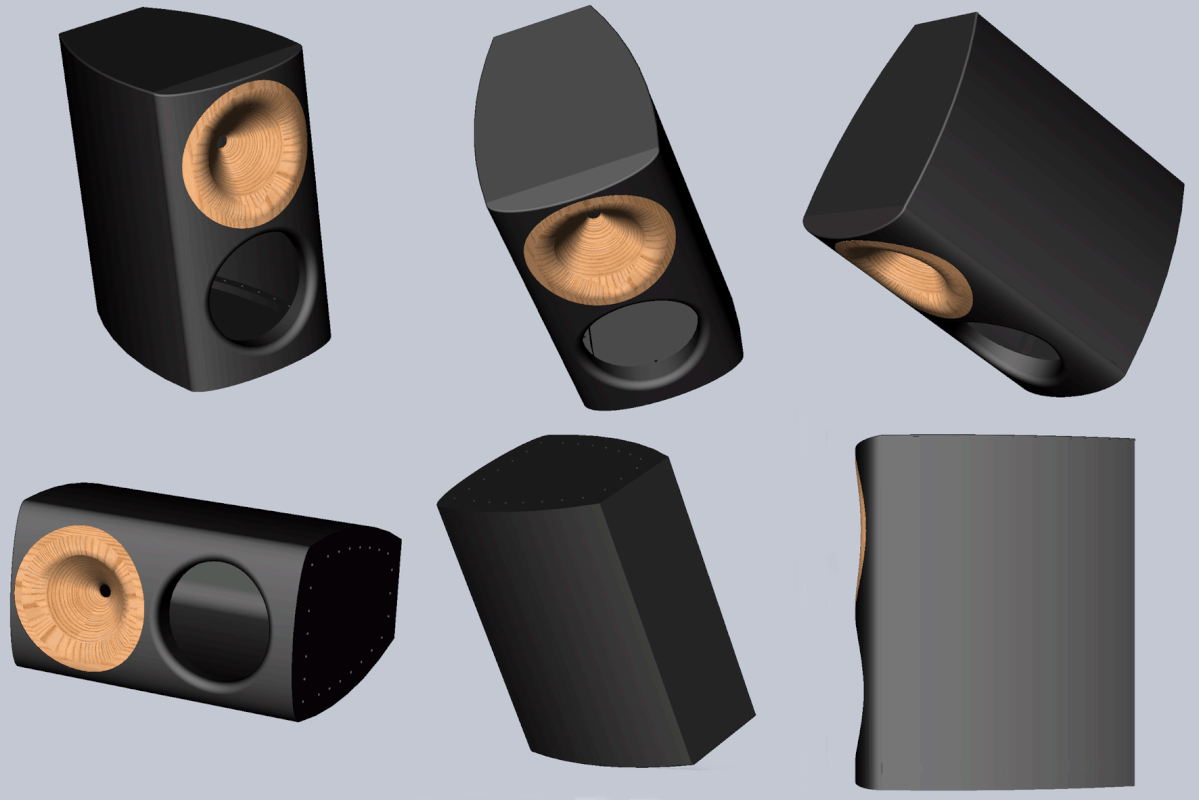
From the thread: "Speakers for megalomaniacs" ( suits me 😉 )

From the thread: "Speakers for megalomaniacs" ( suits me 😉 )
Frankly I don't remember. This is some sketch from a friend of mine. How big this was supposed to be, I don't know. I would guess it was smaller.
The PA-D99 would be the compression driver for megalomaniacs, I guess.
An externally hosted image should be here but it was not working when we last tested it.
Last edited:
Not yet properly, only very quicky. I'll probably leave it to my retirement, in 20-30 years maybe. 😱
...I've updated the crossover several times...
What was the improvement in the crossover?
I have puzzled over the optimum crossover for a horn plus direct radiator for quite a few years.
The issue I see is that if the horn is mounted flush to the baffle, as is important to minimise diffraction, then the depth of the horn leads to a time delay.
I have never seen a systematic analysis of this, just the usual advice to use real measurements, try to optimise the actual response, it's more complicated than an idealised Linkwitz-Riley, and so on.
All true of course but at least the LR crossover showed conceptually an effective way to deal with the phase variation of the respective Low and Hi pass sections.
Is there such an analysis that includes time delay?
It occurs to me that we can subtract out the fixed time delay and consider it the other way round, more or less what DSP does, really.
Then the woofer becomes time advanced compared to the horn reference.
Seems that it should be possible to exploit this to produce results similar to DSP but without A/D D/A conversion.
I have simulated crossovers with delay and achieved reasonably flat results, but not linear phase.
I know this is probably not audible but it would be a nice proof of concept.
Anyone seen a reference to this, or tried it?
Best wishes
David
Last edited:
What was the improvement in the crossover?
I have puzzled over the optimum crossover for a horn plus direct radiator for quite a few years.
The issue I see is that if the horn is mounted flush to the baffle, as is important to minimise diffraction, then the depth of the horn leads to a time delay.
I have never seen a systematic analysis of this, just the usual advice to use real measurements, try to optimise the actual response, it's more complicated than an idealised Linkwitz-Riley, and so on.
All true of course but at least the LR crossover showed conceptually an effective way to deal with the phase variation of the respective Low and Hi pass sections.
Is there such an analysis that includes time delay?
It occurs to me that we can subtract out the fixed time delay and consider it the other way round, more or less what DSP does, really.
Then the woofer becomes time advanced compared to the horn reference.
Seems that it should be possible to exploit this to produce results similar to DSP but without A/D D/A conversion.
I have simulated crossovers with delay and achieved reasonably flat results, but not linear phase.
I know this is probably not audible but it would be a nice proof of concept.
Anyone seen a reference to this, or tried it?
Best wishes
David
Hi Dave, not Earl, but I know a few things about this topic. In computer audio, we often create digital crossovers and time align the drivers, in addition to some frequency and time domain (excess phase) correction, with the FIR filter hosted in a software music players convolution engine. All performed in the digital domain, there is no additional AD/DA conversion.
In the case of Acourate and Audiolense DSP software, in a digital XO'd system, each drivers magnitude response is convolved with the corresponding digital crossover slope, so if one is using digital linear phase crossovers, they sum perfectly in both the frequency and time domain, as discussed and shown in this paper: http://www.acourate.com/XOWhitePaper.pdf
In this article, I use a 3-way digital XO and time align dual subs to double 15" JBL cabs and waveguides. You can see in the screen shots of the DSP software taking into account the delays for each individual driver and offsetting each one with the proper delay: Integrating Subwoofers with Stereo Mains using Audiolense - CA Academy - Audiophile Style You can see by the step response charts, all drivers are time aligned (and not at just one mic position).
A few pics, frequency and step (timing response) with larger subs: Official Rythmik Audio Subwoofer thread - Page 1223 - AVS Forum | Home Theater Discussions And Reviews
I tried an experiment of time corrected versus not time corrected digital XO'd system, with the same frequency response: Integrating Subwoofers with Stereo Mains using Audiolense - CA Academy - Audiophile Style The difference is subtle but audible to these ears.
Cheers!
Mitch
Last edited:
Not really, but here is my take.
There should be no long ringing at LFs as this will sound boomy. The mix of the subs must insure that nothing rings. The room should be well damped (at LFs only!!) usually only effective if the walls are panel absorbers - otherwise too little effect. Tube traps are too little, too late. Then DSP to work yielding a smooth, flat (a few dB rise seems to work best,) uniform LF sound field. This, to me, yields the best bass - the bass that's in the mix, not in the room. Closed boxes are usually better damped than ported, which helps, I think.
It's really FAST!!!
There is a lot of boom lovers here, so i will not ring too long on LF 😀
There is one thing that have puzzled me with the multisub configuration, i've succed to calm down the ringings in my catastrophic room, but the sound field was not uniform.
I'm able to localize one medium sized vented baffle (and also closed) with an accuracy of 100% when sinewaves are applied in the 40-80hz range, could you explain how it is possible ?
There is pehaps someting to say about the size, the drivers selection and the DSP of the subs ?
There is a lot of boom lovers here, so i will not ring too long on LF 😀
There is one thing that have puzzled me with the multisub configuration, i've succed to calm down the ringings in my catastrophic room, but the sound field was not uniform.
I'm able to localize one medium sized vented baffle (and also closed) with an accuracy of 100% when sinewaves are applied in the 40-80hz range, could you explain how it is possible ?
There is pehaps someting to say about the size, the drivers selection and the DSP of the subs ?
Could it be the actual enclosure you're hearing?
There is a lot of boom lovers here, so i will not ring too long on LF 😀
There is one thing that have puzzled me with the multisub configuration, i've succed to calm down the ringings in my catastrophic room, but the sound field was not uniform.
I'm able to localize one medium sized vented baffle (and also closed) with an accuracy of 100% when sinewaves are applied in the 40-80hz range, could you explain how it is possible ?
There is pehaps someting to say about the size, the drivers selection and the DSP of the subs ?
Modal Decays?
- Home
- Loudspeakers
- Multi-Way
- Is it possible to cover the whole spectrum, high SPL, low distortion with a 2-way?
